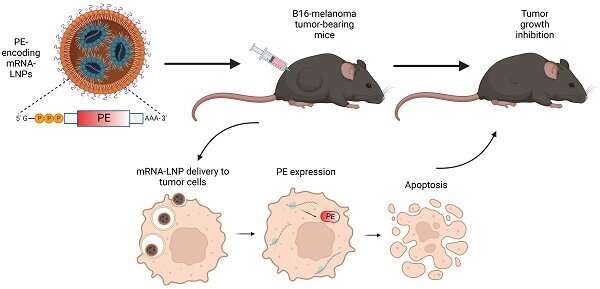
Graphical abstract. Credit: Theranostics (2023). DOI: 10.7150/thno.82228
Researchers at Dan Peer Lab, Tel Aviv University, encoded a toxin produced by bacteria into mRNA (messenger RNA) molecules and delivered these particles directly to cancer cells, causing the cells to produce the toxin – which eventually killed them with a success rate of 50%
For the first time in the world: researchers at Tel Aviv University encoded a toxin produced by bacteria into mRNA (messenger RNA) molecules and delivered these particles directly to cancer cells, causing the cells to produce the toxin – which eventually killed them with a success rate of 50%. The groundbreaking study was led by PhD student Yasmin Granot-Matok and Prof. Dan Peer, a pioneer in the development of RNA therapeutics and Head of the Nanomedicine Laboratory at the Shmunis School of Biomedicine and Cancer Research, also serving as TAU’s VP R&D. The study’s results were published in Theranostics.
Prof. Peer explains: “Many bacteria secrete toxins. The most famous of these is probably the botulinum toxin injected in Botox treatments. Another classic treatment technique is chemotherapy, involving the delivery of small molecules through the bloodstream to effectively kill cancer cells. However, chemotherapy has a major downside: it is not selective, and also kills healthy cells. Our idea was to deliver safe mRNA molecules encoded for a bacterial toxin directly to the cancer cells – inducing these cells to actually produce the toxic protein that would later kill them. It’s like placing a Trojan horse inside the cancer cell.”
First, the research team encoded the genetic info of the toxic protein produced by bacteria of the pseudomonas family into mRNA molecules (resembling the procedure in which genetic info of COVID-19’s ‘spike’ protein was encoded into mRNA molecules to create the vaccine). The mRNA molecules were then packaged in lipid nanoparticles developed in Prof. Peer’s laboratory and coated with antibodies – to make sure that the instructions for producing the toxin would reach their target, the cancer cells. The particles were injected into the tumors of animal models with melanoma skin cancer. After a single injection, 44-60% of the cancer cells vanished.
“In our study, the cancer cell produced the toxic protein that eventually killed it,” says Prof. Peer. “We used pseudomonas bacteria and the melanoma cancer, but this was only a matter of convenience. Many anaerobic bacteria, especially those that live in the ground, secrete toxins, and most of these toxins can probably be used with our method. This is our ‘recipe’, and we know how to deliver it directly to the target cells with our nanoparticles. When the cancer cell reads the ‘recipe’ at the other end it starts to produce the toxin as if it were the bacteria itself and this self-produced toxin eventually kills it. Thus, with a simple injection to the tumor bed, we can cause cancer cells to ‘commit suicide’, without damaging healthy cells. Moreover, cancer cells cannot develop resistance to our technology as often happens with chemotherapy – because we can always use a different natural toxin.”
Original Article: Researchers induce cancer cells to ‘commit suicide’ with a self-produced bacterial toxin
More from: Tel Aviv University
The Latest Updates from Bing News
Go deeper with Bing News on:
Self-produced toxin
- Dr. Google or Dr. Quack: Health misinformation in the TikTok era
Some medical trends are harmless, but many are dangerous. So, how is TikTok changing the face of online medical advice?
- What Are the Short-Term Effects of Alcohol?
Drinking any amount of alcohol comes with many short and long-term effects on the body. Learn more about the immediate dangers and health effects of alcohol.
- 4 Tips for Flawless Summer-Ready Skin
Spring is the perfect time to refresh your skin and revamp your daily skincare routine. As summer approaches, it's important to have a strong skin barrier and the products you need to protect it. As ...
- Chinese military’s work on marine toxins raising new fears of biological warfare weapons
China’s military is conducting research on sea-based neurotoxins, raising new fears among U.S. officials and analysts that Beijing is secretly developing deadly biological weapons for use in a future ...
- Some moths use lethal toxins to deter predators and attract mates
Bella moths (Utetheisa ornatrix) have uniquely adapted to not only consume these substances but also utilize them as a defense mechanism.
Go deeper with Bing News on:
Cancer cell suicide
- Scientists identify cancer families
SCIENTISTS have identified a group of families whose members have a 95% chance of developing cancer. There are thought to be 250 to 350 affected families in the United States, a principal speaker told ...
- After fighting to have gender-affirming care, a former prisoner adjusts to life in Chicago as a woman
Cristina Nichole Iglesias sued the federal Bureau of Prisons for the right to have the surgery and get the agency to pay for it and won.
- The WHO’s broken bot
When asked about suicide, SARAH was prone to give the phone number of ... RNA sequencing aided by AI might one day help doctors predict whether a person’s cancer cells will respond to a specific drug.
- Side effects of 'magic mushrooms' similar to regular antidepressants
People in a new study who took psilocybin often experienced headache, nausea, anxiety, dizziness and elevated blood pressure -- side effects similar to those seen with regular antidepressants.
- ‘Unabomber’ Ted Kaczynski diagnosed with cancer one month before killing himself in prison last year, autopsy reveals
Ted Kaczynski, otherwise known as the Unabomber, had been diagnosed with rectal cancer in 2021, just two years before he died by suicide in prison, according to a new report. Kaczynski was 81 when he ...










